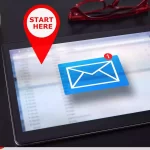A simple question: “When to send your newsletters? “
For example, on Tuesday at 11:11. End of the article, that’s all.
Is such a response adequate for you?
If you hear that someplace, realize that it’s rubbish.
So how to get the right moment and the perfect opportunity, and how to exploit them to enhance profit?
Such a question is often posed by individuals who desire to start with email marketing. This is one of the first things I hear most commonly from newbies.
The more experienced ones don’t ask anymore. They shut the door and locked themselves away for hours. And there, they analyze their numbers.
The bad news is that there is no obvious answer to this issue. And if someone tells you they know it, don’t trust them.
The good news is that finding the right day for you can be quite simple.
But before we dig into selecting the appropriate day and time and the charts I’ve created for you, let’s first answer two questions:
- Why do I want to identify the best day to send it?
- How frequently do I like to send emails?
Why search for the best sending day?
Depending on the kind of emails you send, there may be a difference in the response to this question.
Transactional emails
Confirming an order, thanking you for payment, or replying to an action a person has made are so-called transactional emails.
With these emails, there is also no need to select when to send them. After receiving the order and payment, you must do this as quickly as possible.
So even with this email form, it does not matter when you send them. It could be at 3 in the morning.
Special Offers
You want to tempt clients with a fantastic deal with limited validity. You may provide an intriguing discount on your goods or service. These are exceptional deals.
And here, you need to respond immediately. There is no need to stress excessively over the mailing’s actual timing. Send such an offer instantly as soon as you establish the dates of the event and have made orders. You do not wait for anything. (A little pricey, considering you’re just sending special deals, but that’s another subject…)
Regular newsletters
Regularity makes perfect. People may anticipate frequent newsletters. And when they are intriguing enough, they will start seeking them and create a little habit.
Here, it pays to think about which day will be the most ideal for your newsletter. With these frequent mailings, you should select a defined time and hour when you will send these emails.
How frequently to send emails?
And that’s all for the second question. How many times a week do you want to email contacts from your database? (If you’re thinking “annoying,” get your marketing attitude straight first.)
Mailing once a week – is it a little or a lot? Where is the limit that will be reasonable for your recipients so that they do not feel overwhelmed by your offers?
Here it depends on what sort of company you have and how much you publish.
E-shops, digital items
You may send three emails weekly or more if your firm is primarily online. The primary goal will be to find the arrangement for the mailing within the week.
Such a typical example of an established e-shop with a hundred or more goods might be the following.
- The first email on Monday will include a link to a new blog article.
- In the second letter on Wednesday, you will cover the promotion you are now running.
- In the third email on Thursday, you will showcase a new product from your range.
All these three issues might be incorporated in one email. Well, it would work. But…
One message will fit. Check your email account. In addition, I am a believer in the ” one email = one action ” idea.
That way, you won’t interrupt the receiver, who is reading a new article. In any case, you will no longer have to go back to the e-shop to follow news and deals.
Service-oriented firms
Companies and entrepreneurs that supply services mainly in the living world contact with people live. They don’t have that much time to commit to web marketing and instead want to remind themselves from time to time.
In this scenario, an acceptable frequency is one email each week. You may educate your customers and interested parties about a new item on the website or industry news.
And once in a while, update this regular newsletter with an unusual email—for example, seasonal information, reminders of significant corporate anniversaries, etc.
And why truly seek the ideal email-sending frequency?
If you send emails too frequently, this might happen:
- Recipients will be overloaded with messages and will not be able to read them. They place you in a specific box in their brain and disregard the mailing. Until once a year or two, they log off.
- They may designate your emails as SPAM. There’s such a button on both List and Gmail, and people are clicking on it. Even though your communication is not technically SPAM, the receiver has begun to regard it as such.
- You will be spending time and money on generating and publishing that will not earn a profit. Content marketing is good, but yet constantly looks at ROI.
If, on the other hand, you send few emails, you risk:
- Recipients will forget about you and subsequently identify you or your business as a spammer. Because after a few months, they don’t recall how they came to you… (Who the heck is that firm.)
- You breach trust before the first transaction is made, and the receiver has to find their way back to you.
- Readers may feel like you’re snubbing them. Especially when you promise them anything and the “deed runs away”.
The proper time to hunt for the ideal day and hour is only after you decide how many messages and how often you want to send emails.
General views of the dispatch time
Day vs night
Logically, the option is presented that most emails will be opened throughout the day. But you may be shocked how many people frequently check your emails after midnight. Maybe after the third hour.
Work week vs weekend
B2B enterprises can virtually forget about the weekend. Sure, a few geeks want to educate themselves, but the great majority of managers and employees are enjoying their families or growing up drunk.
On the contrary, ordinary humans do not have the time or inclination to study and solve anything during the working week and prefer to wait for the weekend when they have good solitude.
Morning vs evening
Also, pick the time of day of the mailing according to your client. If your consumer is an average guy, let’s call him Frank, for example, then it will be more suitable to send a message so that he may read it in the evening and respond with a purchase. Only some people can check their email boxes at work and read new messages throughout the day.
But if you’re reaching out to employees, it could be excellent if your message appears in their inbox just at 09:00 when they’re drinking their morning coffee.
Day of the week
I performed research and gathered statistics about email openings and click-through rates throughout the week.
You may think to yourself:” On Mondays, individuals are generally overloaded with chores and remove what they can. “
But I had positive experiences with Mondays.
We have had a campaign conclude on Monday several times, and the results have been spectacular. After the weekend, people are refreshed and joyful.
They also have a lot of work, so they don’t want to dwell too long. They want to make a speedy choice and go on.
For example, she Typically provides a piece of brief encouraging advice every Monday. Nothing complicated, no sales.
So it’s hard to quantify click-through rates and conversions. Just a little motivation and the day begins wonderfully. And their receivers enjoy those recommendations. Once the tip didn’t go, they instantly had various reactions:” Where’s my advice? “
Any day of the week might be your perfect day.
Focus on the clicks
That is more important than analyzing the opening of emails. It’s necessary to monitor the actual clicks on the links (or, even better, conversions).
Usually, when the receiver opens the email, they click on the link. And for one simple reason. He doesn’t have time.
In today’s age of smartphones, we generally access email through our mobile phones. During the day, we regularly check what we have received via email.
But there is no time to read the full-length article or check the promotional offer. Only when it’s the right moment of quiet do we occasionally sit down, browse through emails and click on a link on our mobile phone or straight on our computer.
So don’t only monitor the available time, but rather the clicks. And to determine the optimal time for sending, you may use…
Two options for distribution
An emotional solution
You are the ruler of your company. You can reach some people. Maybe you don’t even want to.
By picking what you transmit according to your interests, you will instantly attract a specific target group, and it is very conceivable that they will be individuals similar to you.
For example, you may select a day of the week that matches your company’s working schedule. When you know that you have a regular business meeting on Monday morning, it is impossible to plan your newsletter at that time.
You have to prepare the newsletter a week ahead, and a lot might happen at the weekend.
For example, for 3 years, I consistently mailed on Tuesdays. And the reason was simple. I prefer to do things at the last minute.
I can fine-tune the newsletter on Tuesday and submit it immediately away. In principle, I could have been more available on another day, but this benefit was not a priority for me above having to change my work week.
A/B testing
The second technique is based on the study of the behaviour of the market – the readers of your emails themselves.
Thanks to data analysis and testing, you can determine the optimum timing for your receiver. Browsing data takes some time. Therefore it could be better for some, especially for self-employed workers and smaller organizations.
In addition, in order for the testing to be successful, it is essential to have a sufficiently extensive database of contacts (several thousand contacts). And this may be an issue for most entrepreneurs and firms just starting with email marketing.
In brief, I will remind you what A/B testing is.
Simply put, it’s a method where you split the receiver into two or more groups and send an email to each of them simultaneously.
During A/B testing, you may vary the substance of the email itself (subjects, content, sender), but such testing would be more destructive to you when establishing the best sending time.
After a few days, you will look at the opens and clicks. It is great to monitor the conversions themselves, e.g. purchases in the e-shop. Based on the acquired data, you will next assess which of the tested groups achieved superior outcomes. And you will use this as a foundation for another, another and another test…
Using an excellent marketing automation service, I will illustrate what such a setup may look like. Among other things, you may test the date and time of sending.
- You pick at least two delivery dates.
- You split receivers into two or more categories.
- You decide the duration of the test.
- Then it is enough to assess the exam.
Although it only sometimes works 100%.
Some time ago, I also tried the day and hour of delivering a newsletter to a customer. The first variation departed on Friday afternoon, and the second on Monday afternoon.
And the result?
The same. But we discovered that different people opened the email on Friday than on Monday.
And this leads to two options: Either send more emails or employ more powerful technologies…
Send Time Optimization – STO
It is a strategy where the mailing tool analyzes, depending on past data, when which receiver most typically opens your emails. Individually. And your newsletter will be delivered to him a second before he checks the inbox.
If Frank checks emails on Sunday evening, the newsletter will be delivered to him on Sunday. On the contrary, he writes an identical email to Eva on Tuesday morning.
To maximize the mailing, you may pick 24 hours or choose a span of the whole week.
Conclusion
Regularity is considerably more essential than time itself. It also relies a lot on your field and your numbers.
Test and observe the behaviour of your receivers, and you will undoubtedly identify the ideal moment for your mailings.
If you are going to send a regular newsletter, pick a particular day of the week and even a defined hour. It doesn’t matter what since subscribers will become accustomed to that day and time and anticipate your message.
And take advantage, for example, of the fact that most firms send their emails from Tuesday to Thursday. You may locate another day outside of these days. And who knows? It may be to your benefit.





